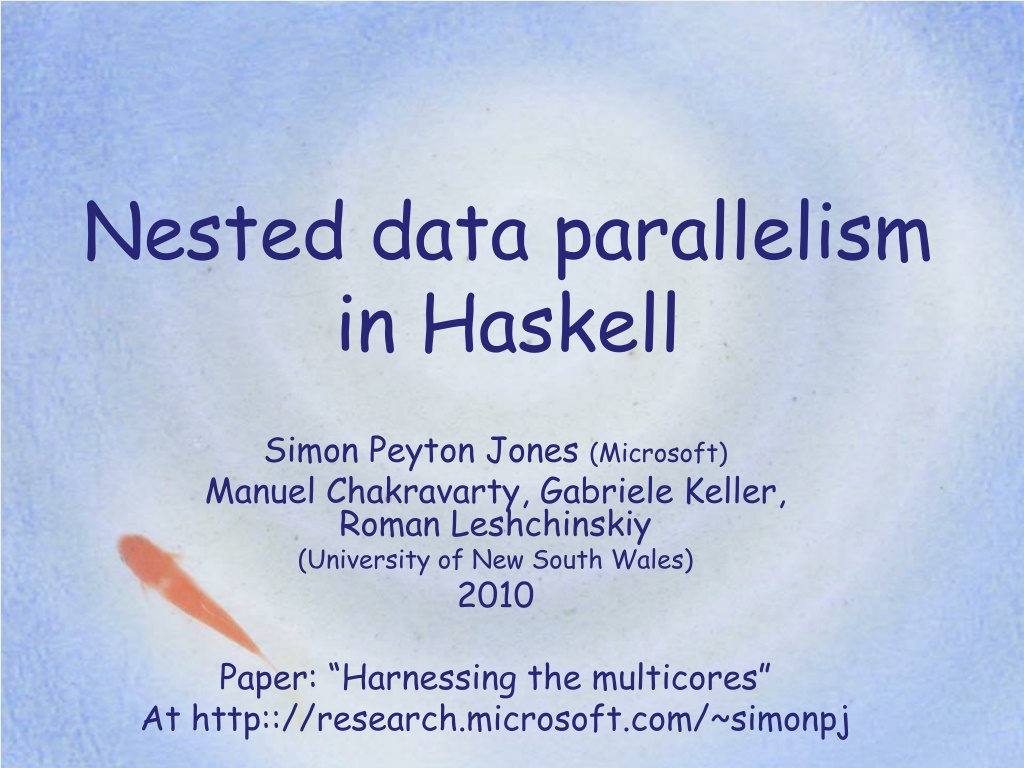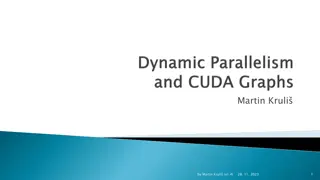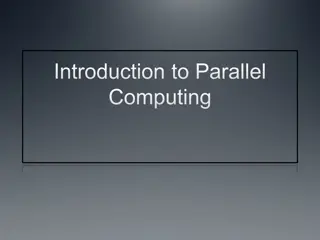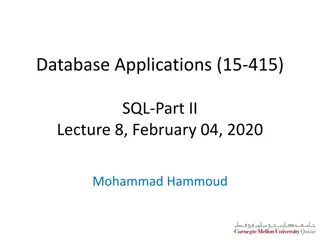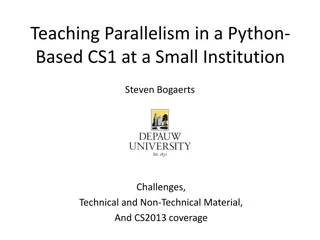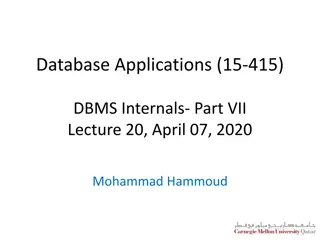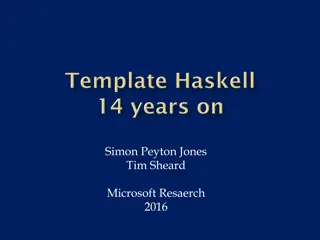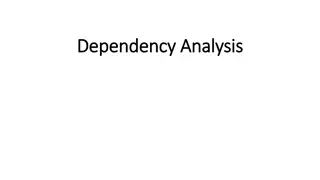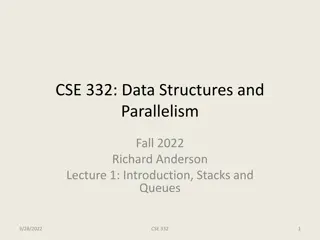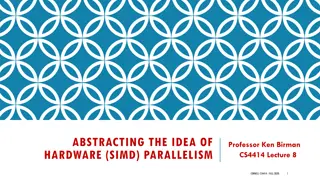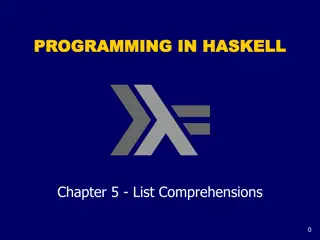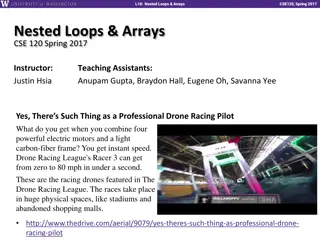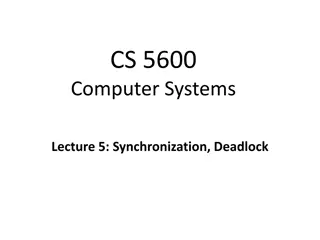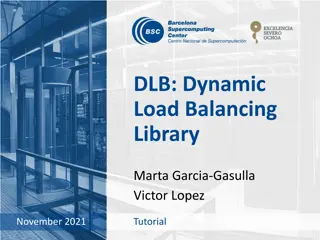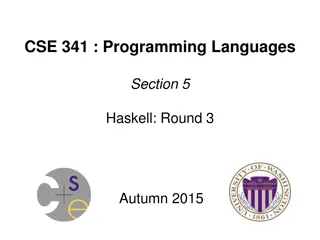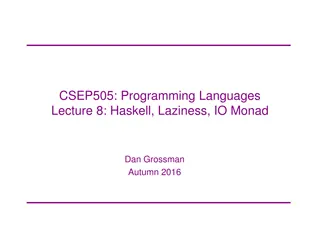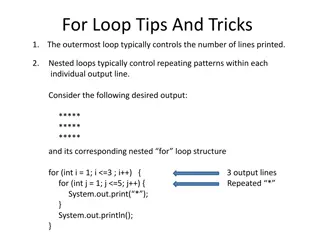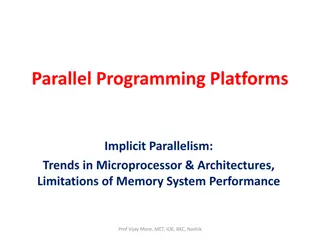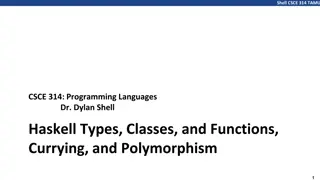Overview of Nested Data Parallelism in Haskell
The paper by Simon Peyton Jones, Manuel Chakravarty, Gabriele Keller, and Roman Leshchinskiy explores nested data parallelism in Haskell, focusing on harnessing multicore processors. It discusses the challenges of parallel programming, comparing sequential and parallel computational fabrics. The evolution from failed attempts in the 80s to the present state with functional programming and the use of DSLs for GPU programs is highlighted. The roadmap for multicore parallel programming is outlined, emphasizing task parallelism, data parallelism, and massive parallelism. The versatility of Haskell's concurrency features, including explicit threads, non-deterministic and monadic operations, and deterministic data parallelism, is also detailed.
Download Presentation

Please find below an Image/Link to download the presentation.
The content on the website is provided AS IS for your information and personal use only. It may not be sold, licensed, or shared on other websites without obtaining consent from the author.If you encounter any issues during the download, it is possible that the publisher has removed the file from their server.
You are allowed to download the files provided on this website for personal or commercial use, subject to the condition that they are used lawfully. All files are the property of their respective owners.
The content on the website is provided AS IS for your information and personal use only. It may not be sold, licensed, or shared on other websites without obtaining consent from the author.
E N D
Presentation Transcript
Nested data parallelism in Haskell Simon Peyton Jones (Microsoft) Manuel Chakravarty, Gabriele Keller, Roman Leshchinskiy (University of New South Wales) 2010 Paper: Harnessing the multicores At http:://research.microsoft.com/~simonpj
Thesis The free lunch is over. Muticores are here. we have to program them. This is hard. Yada-yada-yada. Programming parallel computers Plan A. Start with a language whose computational fabric is by-default sequential, and by heroic means make the program parallel Plan B. Start with a language whose computational fabric is by-default parallel Plan B will win. Parallel programming will increasingly mean functional programming
Antithesis Parallel functional programming was tried in the 80 s, and basically failed to deliver Then Now Uniprocessors were getting faster really, really quickly. Our compilers were crappy naive, so constant factors were bad The parallel guys were a dedicated band of super-talented programmers who would burn any number of cycles to make their supercomputer smoke. Parallel computers were really expensive, so you needed 95% utilisation Uniprocessors are stalled Compilers are pretty good They are regular Joe Developers Everyone will has 8, 16, 32 cores, whether they use em or not. Even using 4 of them (with little effort) would be a Jolly Good Thing
Antithesis Parallel functional programming was tried in the 80 s, and basically failed to deliver Then Now We had no story about (a) locality, (b) exploiting regularity, and (c) granularity We have DSLs for generating GPU programs (Harvard, UNSW, Chalmers, Microsoft) This talk
Road map Multicore Parallel programming essential Task parallelism Explicit threads Synchronise via locks, messages, or STM Data parallelism Operate simultaneously on bulk data Massive parallelism Easy to program Single flow of control Implicit synchronisation Modest parallelism Hard to program
Haskell has three forms of concurrency Explicit threads Non-deterministic by design Monadic: forkIO and STM Semi-implicit Deterministic Pure: par and seq Data parallel Deterministic Pure: parallel arrays Shared memory initially; distributed memory eventually; possibly even GPUs General attitude: using some of the parallel processors you already have, relatively easily main :: IO () = do { ch <- newChan ; forkIO (ioManager ch) ; forkIO (worker 1 ch) ... etc ... } f :: Int -> Int f x = a `par` b `seq` a + b where a = f (x-1) b = f (x-2)
Data parallelism The key to using multicores Flat data parallel Apply sequential operation to bulk data Nested data parallel Apply parallel operation to bulk data The brand leader Limited applicability (dense matrix, map/reduce) Well developed Limited new opportunities Developed in 90 s Much wider applicability (sparse matrix, graph algorithms, games etc) Practically un-developed Huge opportunity
e.g. Fortran(s), *C MPI, map/reduce Flat data parallel The brand leader: widely used, well understood, well supported foreach i in 1..N { ...do something to A[i]... } BUT: something is sequential Single point of concurrency Easy to implement: use chunking Good cost model P1 P2 P3 1,000,000 s of (small) work items
Nested data parallel Main idea: allow something to be parallel foreach i in 1..N { ...do something to A[i]... } Now the parallelism structure is recursive, and un-balanced Still good cost model Still 1,000,000 s of (small) work items
Nested DP is great for programmers Fundamentally more modular Opens up a much wider range of applications: Sparse arrays, variable grid adaptive methods (e.g. Barnes-Hut) Divide and conquer algorithms (e.g. sort) Graph algorithms (e.g. shortest path, spanning trees) Physics engines for games, computational graphics (e.g. Delauny triangulation) Machine learning, optimisation, constraint solving
Nested DP is tough for compilers ...because the concurrency tree is both irregular and fine-grained But it can be done! NESL (Blelloch 1995) is an existence proof Key idea: flattening transformation: Flat data parallel program (the one we want to run) Nested data parallel program (the one we want to write) Compiler
Array comprehensions [:Float:] is the type of parallel arrays of Float vecMul :: [:Float:] -> [:Float:] -> Float vecMul v1 v2 = sumP [: f1*f2 | f1 <- v1 | f2 <- v2 :] sumP :: [:Float:] -> Float An array comprehension: the array of all f1*f2 where f1 is drawn from v1 and f2 from v2 Operations over parallel array are computed in parallel; that is the only way the programmer says do parallel stuff NB: no locks!
Sparse vector multiplication A sparse vector is represented as a vector of (index,value) pairs svMul :: [:(Int,Float):] -> [:Float:] -> Float svMul sv v = sumP [: f*(v!i) | (i,f) <- sv :] Parallelism is proportional to length of sparse vector v!i gets the i th element of v
Sparse matrix multiplication A sparse matrix is a vector of sparse vectors smMul :: [:[:(Int,Float):]:] -> [:Float:] -> Float smMul sm v = sumP [: svMul sv v | sv <- sm :] Nested data parallelism here! We are calling a parallel operation, svMul, on every element of a parallel array, sm
Hard to implement well Evenly chunking at top level might be ill-balanced Top level along might not be very parallel
The flattening transformation Concatenate sub-arrays into one big, flat array Operate in parallel on the big array Segment vector keeps track of where the sub-arrays are ...etc Lots of tricksy book-keeping! Possible to do by hand (and done in practice), but very hard to get right Blelloch showed it could be done systematically
Fusion Flattening is not enough vecMul :: [:Float:] -> [:Float:] -> Float vecMul v1 v2 = sumP [: f1*f2 | f1 <- v1 | f2 <- v2 :] Do not Generate [: f1*f2 | f1 <- v1 | f2 <- v2 :] (big intermediate vector) 2. Add up the elements of this vector Instead: multiply and add in the same loop That is, fuse the multiply loop with the add loop Very general, aggressive fusion is required 1.
Parallel search type Doc = [: String :] -- Sequence of words type DocBase = [: Document :] search :: DocBase -> String -> [: (Doc,[:Int:]):] Find all Docs that mention the string, along with the places where it is mentioned (e.g. word 45 and 99)
Parallel search type Doc = [: String :] type DocBase = [: Document :] search :: DocBase -> String -> [: (Doc,[:Int:]):] Parallel search wordOccs :: Doc -> String -> [: Int :] Find all the places where a string is mentioned in a document (e.g. word 45 and 99)
Parallel search type Doc = [: String :] type DocBase = [: Document :] search :: DocBase -> String -> [: (Doc,[:Int:]):] search ds s = [: (d,is) | d <- ds , let is = wordOccs d s Parallel search , not (nullP is) :] wordOccs :: Doc -> String -> [: Int :] nullP :: [:a:] -> Bool
Parallel search type Doc = [: String :] type DocBase = [: Document :] search :: DocBase -> String -> [: (Doc,[:Int:]):] Parallel search wordOccs d s = [: i | (i,s2) <- zipP positions d , s == s2 :] where positions :: [: Int :] positions = [: 1..lengthP d :] wordOccs :: Doc -> String -> [: Int :] zipP :: [:a:] -> [:b:] -> [:(a,b):] lengthP :: [:a:] -> Int
Data-parallel quicksort sort :: [:Float:] -> [:Float:] sort a = if (lengthP a <= 1) then a else sa!0 +++ eq +++ sa!1 where m = a!0 lt = [: f | f<-a, f<m :] eq = [: f | f<-a, f==m :] gr = [: f | f<-a, f>m :] sa = [: sort a | a <- [:lt,gr:] :] Parallel filters 2-way nested data parallelism here!
How it works Step 1 sort sort sort Step 2 Step 3 sort sort sort ...etc... All sub-sorts at the same level are done in parallel Segment vectors track which chunk belongs to which sub problem Instant insanity when done by hand
In Harnessing the multicores All the examples so far have been small In the paper you ll find a much more substantial example: the Barnes-Hut N-body simulation algorithm Very hard to fully parallelise by hand
What we are doing about it Substantial improvement in Expressiveness Performance NESL a mega-breakthrough but: specialised, prototype first order few data types no fusion interpreted Shared memory initially Distributed memory eventually GPUs anyone? Haskell broad-spectrum, widely used higher order very rich data types aggressive fusion compiled
Main contribution: an optimising data-parallel compiler implemented by modest enhancements to a full-scale functional language implementation Four key pieces of technology 1. Flattening specific to parallel arrays 2. Non-parametric data representations A generically useful new feature in GHC 3. Chunking Divide up the work evenly between processors 4. Aggressive fusion Uses rewrite rules , an old feature of GHC
Overview of compilation Not a special purpose data-parallel compiler! Most support is either useful for other things, or is in the form of library code. Typecheck Desugar The flattening transformation (new for NDP) Main focus of the paper Vectorise Chunking and fusion ( just library code) Optimise Code generation
Step 0: desugaring svMul :: [:(Int,Float):] -> [:Float:] -> Float svMul sv v = sumP [: f*(v!i) | (i,f) <- sv :] sumP :: Num a => [:a:] -> a mapP :: (a -> b) -> [:a:] -> [:b:] svMul :: [:(Int,Float):] -> [:Float:] -> Float svMul sv v = sumP (mapP (\(i,f) -> f * (v!i)) sv)
Step 1: Vectorisation svMul :: [:(Int,Float):] -> [:Float:] -> Float svMul sv v = sumP (mapP (\(i,f) -> f * (v!i)) sv) sumP *^ fst^ bpermuteP :: [:a:] -> [:Int:] -> [:a:] :: Num a => [:a:] -> a :: Num a => [:a:] -> [:a:] -> [:a:] :: [:(a,b):] -> [:a:] svMul :: [:(Int,Float):] -> [:Float:] -> Float svMul sv v = sumP (snd^ sv *^ bpermuteP v (fst^ sv)) Scalar operation * replaced by vector operation *^
Vectorisation: the basic idea mapP f v f^ v f :: T1 -> T2 f^ :: [:T1:] -> [:T2:] -- f^ = mapP f For every function f, generate its lifted version, namely f^ Result: a functional program, operating over flat arrays, with a fixed set of primitive operations *^, sumP, fst^, etc. Lots of intermediate arrays!
Vectorisation: the basic idea f :: Int -> Int f x = x+1 f^ :: [:Int:] -> [:Int:] f^ x = x +^ (replicateP (lengthP x) 1) This Transforms to this Locals, x Globals, g Constants, k x g^ replicateP (lengthP x) k replicateP :: Int -> a -> [:a:] lengthP :: [:a:] -> Int
Vectorisation: the key insight f :: [:Int:] -> [:Int:] f a = mapP g a = g^ a f^ :: [:[:Int:]:] -> [:[:Int:]:] f^ a = g^^ a --??? Yet another version of g???
Vectorisation: the key insight f :: [:Int:] -> [:Int:] f a = mapP g a = g^ a First concatenate, then map, then re-split f^ :: [:[:Int:]:] -> [:[:Int:]:] f^ a = segmentP a (g^ (concatP a)) concatP :: [:[:a:]:] -> [:a:] segmentP :: [:[:a:]:] -> [:b:] -> [:[:b:]:] Shape Flat data Nested data Payoff: f and f^ are enough. No f^^
Step 2: Representing arrays [:Double:] Arrays of pointers to boxed numbers are Much Too Slow [:(a,b):] Arrays of pointers to pairs are Much Too Slow ... Idea! Representation of an array depends on the element type
Step 2: Representing arrays [POPL05], [ICFP05], [TLDI07] data family [:a:] data instance [:Double:] = AD ByteArray data instance [:(a,b):] = AP [:a:] [:b:] AP Now *^ is a fast loop And fst^ is constant time! fst^ :: [:(a,b):] -> [:a:] fst^ (AP as bs) = as
Step 2: Nested arrays Shape Flat data data instance [:[:a:]:] = AN [:Int:] [:a:] concatP :: [:[:a:]:] -> [:a:] concatP (AN shape data) = data segmentP :: [:[:a:]:] -> [:b:] -> [:[:b:]:] segmentP (AN shape _) data = AN shape data Surprise: concatP, segmentP are constant time!
Higher order complications f :: T1 -> T2 -> T3 f1^ :: [:T1:] -> [:T2:] -> [:T3:] - f1^ = zipWithP f f2^ :: [:T1:] -> [:(T2 -> T3):] -- f2^ = mapP f f1^ is good for [: f a b | a <- as | b <- bs :] But the type transformation is not uniform And sooner or later we want higher-order functions anyway f2^ forces us to find a representation for [:(T2->T3):]. Closure conversion [PAPP06]
Step 3: chunking svMul :: [:(Int,Float):] -> [:Float:] -> Float svMul (AP is fs) v = sumP (fs *^ bpermuteP v is) Program consists of Flat arrays Primitive operations over them (*^, sumP etc) Can directly execute this (NESL). Hand-code assembler for primitive ops All the time is spent here anyway But: intermediate arrays, and hence memory traffic each intermediate array is a synchronisation point Idea: chunking and fusion
Step 3: Chunking svMul :: [:(Int,Float):] -> [:Float:] -> Float svMul (AP is fs) v = sumP (fs *^ bpermuteP v is) 1. Chunking: Divide is,fs into chunks, one chunk per processor 2. Fusion: Execute sumP (fs *^ bpermute v is) in a tight, sequential loop on each processor 3. Combining: Add up the results of each chunk Step 2 alone is not good for a parallel machine!
Expressing chunking sumP :: [:Float:] -> Float sumP xs = sumD (mapD sumS (splitD xs) splitD :: [:a:] -> Dist [:a:] mapD :: (a->b) -> Dist a -> Dist b sumD :: Dist Float -> Float sumS :: [:Float:] -> Float -- Sequential! sumS is a tight sequential loop mapD is the true source of parallelism: it starts a gang , runs it, waits for all gang members to finish
Expressing chunking *^ :: [:Float:] -> [:Float:] -> [:Float:] *^ xs ys = joinD (mapD mulS (zipD (splitD xs) (splitD ys)) splitD :: [:a:] -> Dist [:a:] joinD :: Dist [:a:] -> [:a:] mapD :: (a->b) -> Dist a -> Dist b zipD :: Dist a -> Dist b -> Dist (a,b) mulS :: ([:Float:],[: Float :]) -> [:Float:] Again, mulS is a tight, sequential loop
Step 4: Fusion svMul :: [:(Int,Float):] -> [:Float:] -> Float svMul (AP is fs) v = sumP (fs *^ bpermuteP v is) = sumD . mapD sumS . splitD . joinD . mapD mulS $ zipD (splitD fs) (splitD (bpermuteP v is)) Aha! Now use rewrite rules: {-# RULE splitD (joinD x) = x mapD f (mapD g x) = mapD (f.g) x #-} svMul :: [:(Int,Float):] -> [:Float:] -> Float svMul (AP is fs) v = sumP (fs *^ bpermuteP v is) = sumD . mapD (sumS . mulS) $ zipD (splitD fs) (splitD (bpermuteP v is))
Step 4: Sequential fusion svMul :: [:(Int,Float):] -> [:Float:] -> Float svMul (AP is fs) v = sumP (fs *^ bpermuteP v is) = sumD . mapD (sumS . mulS) $ zipD (splitD fs) (splitD (bpermuteP v is)) Now we have a sequential fusion problem. Problem: lots and lots of functions over arrays we can t have fusion rules for every pair New idea: stream fusion
In Harnessing the multicores The paper gives a much more detailed description of The vectorisation transformation The non-parametric representation of arrays This stuff isn t new, but the paper gathers several papers into a single coherent presentation (There s a sketch of chunking and fusion too, but the main focus is on vectorisation.)
Speedup for SMVN on 8-core UltraSparc 10 Speedup 1 Speedup (prim) Speedup (vect) 1 = Speed of sequential C program on 1 core = a tough baseline to beat 0.1 1 2 4 8 16 32 64 Number of threads
Less good for Barnes-Hut Barnes Hut 3 2.5 2 Speedup 1.5 1 0.5 0 1 2 3 4 Number of processors
Purity pays off Two key transformations: Flattening Fusion Both depend utterly on purely- functional semantics: no assignments every operation is a pure function The data-parallel languages of the future will be functional languages
Summary Data parallelism is the only way to harness 100 s of cores Nested DP is great for programmers: far, far more flexible than flat DP Nested DP is tough to implement. We are optimistic, but have some way to go. Huge opportunity: almost no one else is dong this stuff! Functional programming is a massive win in this space WANTED: friendly guinea pigs http://haskell.org/haskellwiki/GHC/Data_Parallel_Haskell Paper: Harnessing the multicores on my home page
